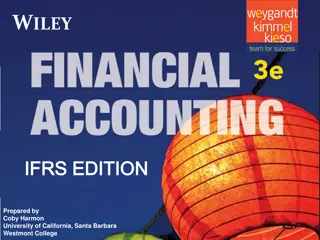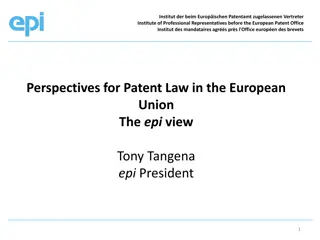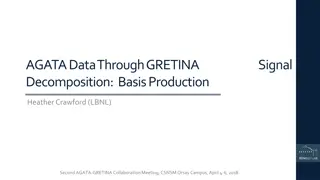Accounting Basis Diagnostic Tool for NPOs and Funders
This diagnostic tool focuses on cash, modified cash, and accrual basis accounting for Non-Profit Organizations (NPOs) and funders. It explains the impact of accounting basis decisions and how to utilize the tool effectively. Designed for NPOs and funders, it helps in understanding, negotiating, and making strategic choices regarding accounting and reporting practices.
Download Presentation

Please find below an Image/Link to download the presentation.
The content on the website is provided AS IS for your information and personal use only. It may not be sold, licensed, or shared on other websites without obtaining consent from the author. Download presentation by click this link. If you encounter any issues during the download, it is possible that the publisher has removed the file from their server.
E N D
Presentation Transcript
Accounting Basis: Diagnostic and Strategy Tool for NPOs and funders Cash, modified cash and accrual basis
Introduction 1. 2. 3. About the tool Accounting in NPOs Cash , accrual and modified cash Accounting basis used in different reports Impact of accounting basis decisions How to use the tool 4. Please read this slide deck in slide show mode, using the mouse or arrows to click 5. 6.
About Humentum Humentum partners with the global development community to be an equitable, accountable, resilient force for social good. Humentum provides training, convening, and consulting support for member organizations and clients working in global relief and development by strengthening operations functions: compliance and risk, financial management, program management, and HR/learning. For more information, please visit https://www.humentum.org. 3
Section 1 About the tool 4
1.1 Who is this tool designed for? The tool is designed for: non-profit organisations funders that request financial reports from NPOs This slide deck explains the background to the tool and how to use it. A link to the tool itself is in the final slide 5
1.2 What can the tool do for NPOs? NPOs (as grantees) may use the tool to: Understand whether those practices are the result of compliance requirements, strategic choices or history Clearly describe the basis currently used its own current accounting and reporting practice Negotiate with donors where strategic choices or legal requirements differ from donor requirements. Make strategic choices about the accounting and reporting practices it would like to use 6
1.3 What can the tool do for funders? Funders may use the tool to: Clearly describe the accounting basis currently allowed or required for its grantee reporting practice Understand whether current practice is the result of compliance requirements, strategic choices or history Negotiate with grantees where their strategic choices or legal requirements differ from funder reporting requirements. Make strategic choices about the accounting and reporting practices it would like to require or allow 7
1.4 What can the tool NOT do? The tool does not Prescribe what is the best or right accounting basis for any given type of transaction, organisation, financial report or funder requirement. Consider every possible type of transaction. It includes those transactions deemed most common in the NPO sector globally, both exchange and non-exchange. Define a standard for accrual-based accounting for NPOs. There is currently no internationally applicable standard, which is why Guidance is being developed by the IFR4NPO project. 8
Section 2 Accounting in NPOs 9
2.1 Simple or complex? Accounting and financial reporting should always be As simple as possible to meet the needs Appropriate to the context of the organisation There are cost / benefit trade-offs to increasing complexity or sophistication. 10
2.2 Goals of accounting in NPOs Useful information Internal and external users Decision making and accountability Control Use accounting practice Part of effective internal control Maximise income Recover all project costs (including indirect) From project funders The selection of accounting treatments in the tool reflect all of the above goals. 11
Section 3 Cash, accrual and modified basis accounting 12
3.1 Accounting basis A financial transaction may be recorded on either : An accrual basis A cash basis or 13
3.2 Cash accounting Cash accounting records transactions at the point when money is received and paid by an entity Maintaining cashbooks for different bank or mobile money accounts, cashboxes and staff working advances is an essential foundation of all accounting. Pure cash accounting does not keep track of debtors or creditors, prepayments, accruals, assets, depreciation or commitments. In a nutshell: Essential foundation Simpler to do Less information 14
3.3 Accrual accounting Accrual accounting recognises income and expenditure at the point when it is earned or accrued, as distinct from when it is received or paid. Accrual accounting includes the capitalisation of fixed assets, and recognition of stocks, debtors and creditors and other liabilities. In a nutshell: More complex Richer information Income may be recognised on the basis of entitlement, whether or not it is actually in the bank. 15
3.4 Accounting Basis a binary choice? Cash basis or accrual basis? At transaction level, this is true any given transaction may be captured on a cash only basis, or on an accrual basis (There may be more than one way to report a transaction on an accrual basis, which is why accounting standards are necessary) But what if some transactions a recorded on a cash basis and some are on an accrual basis? 16
3.5 Modified basis Financial reports Transaction basis Cash basis reports (eg receipts and payments report) All on a cash basis Modified cash (or hybrid) basis reports Some on cash basis, others on accrual basis Accrual basis reports (eg income statement, balance sheet) All on an accrual basis (as required by a standard) Full accrual basis Cash basis Modified cash basis Mostly cash, some accrual Defined by standards Mostly accrual, some cash Clearly defined A spectrum, not binary 17
3.6 Where on the spectrum? What is the most appropriate place on the spectrum for a particular NPO? Consider these factors: Operations Does the NPO have assets or liabilities that need to be tracked? Transactions Does the NPO have transactions where there is a timing difference between the value received or given and the movement of money? Funding sources does the NPO have multiple funding sources or different currency bank accounts? Non-cash entries such as revaluations and cost allocations may become necessary Strategy does the NPO wish to grow or improve the rate at which it recovers indirect project costs from funders? Size is a relatively easy proxy or estimate of an NPO s need to consider accrual-based information. 18
3.7 Internal and external influences Full accrual basis Cash basis Modified cash basis Size Capacity constraints Standards or regulators Donor requirements Some donors may require cash basis irrespective of NPO needs or capacity Accrual based information is less relevant for very small NPOs Some NPOs lack the capacity to prepare the information they need Varied by country, but International Accounting Standards are accrual based 19
Section 4 Different reports where accounting basis is relevant 20
4.1 Outputs from the accounting system An NPO accounting system needs to be set up so that it can provide information for: internal users such as project managers, budget holders, management and board; and funders or donors of particular projects, as needed Other external users such as banks, regulators, service recipients, partners, and the public. 21
4.2 Options for NPOs 1. Internal reports Day to day Provides information for internal decisions Which accounting basis should be used for each? 2. Donor reports Project based Often produced monthly or quarterly 3. Annual accounts Entity wide Often needed by regulators or bankers 22
Section 5 Impact of accounting basis conflicts 23
5.1 Accounting basis conflicts (1) One system cannot (readily) produce reports on different bases What if an NPO would like to track payroll assets and liabilities (modified basis) for its own internal reports, but its donors require project reports on a cash basis? 24
5.2 Accounting basis conflicts (2) One system cannot (readily) produce reports on different bases What if an NPO s donor reports are required to be prepared on a particular modified basis (eg with equipment expensed) but the annual accounts are required to be on a full accrual basis (with asset capitalisation and depreciation)? 25
5.3 Impact of conflicts Decisions about accounting basis for different types of reports can impact the following areas: Fraud: can donor reports be reconciled to the year-end audited accounts, which is important for fighting double-funding fraud? Reporting efficiency: can one system can produce all reports, with a minimum of post-ledger (outside the system) manipulation and adjustments in spreadsheets? Are budgets and actuals on the same accounting basis? Governance: isinformation about financial health available to board members and senior management throughout the year? Are the year-end accounts in a familiar format? External users: are the needs of external users met? 26
5.4 Scenarios The following scenarios assume a generalised Non-Profit Organisation that: is of a size and complexity where at least some accrual based information would be important has the staff, systems and governance capacity to produce and use at least some accrual based information has some donor funding Each scenario considers the impact of accounting basis decisions on the factors on the previous slide, scoring from 4 (best) to 0 (worst) The purpose is to consider some examples where there are trade- offs of different options. Each organisation should consider the scores and trade offs in their own context. 27
5.5 Scenario 1 Report and frequency Basis Internal reports (monthly) Cash basis Fraud (double funding) Donor and year-end reports on the same basis should be reconcilable Donor reports (quarterly) Cash basis Audited accounts (annually) Cash basis Efficiency All three types of report are on the same basis, easy to monitor budgets Governance Consistency between quarterly and year-end reports is helpful, but limited without information about assets or liabilities. Area Score 8 External users The IFR4NPO Project Consultation Paper Chapter 3 makes the case why accrual based information is appropriate for external users. Fighting fraud 3 Reporting efficiency 4 Governance 1 External users 0 28
5.5 Scenario 2 Report and frequency Basis Internal reports (monthly) Cash basis Fraud (double funding) Donor reports not reconcilable to year-end accounts Donor reports (quarterly) Cash basis Audited accounts (annually) Accrual basis Efficiency Monthly and quarterly reports are on the same basis, but considerable effort needed for year end accounts. Governance Year-end accounts are on a different basis from during the year. Quarterly reports lack information about assets and liabilities. Area Score 7 External users Accrual-based information most useful for a range of users. Fighting fraud 0 Reporting efficiency 2 Governance 1 External users 4 29
5.5 Scenario 3 Report and frequency Basis Fraud (double funding) Donor reports not readily reconcilable to year-end accounts Internal reports (monthly) Modified basis Donor reports (quarterly) Modified basis Audited accounts (annually) Accrual basis Efficiency Monthly and quarterly reports are on the modified basis (although not necessarily aligned), with relatively little effort needed for year end accounts Governance Board reports include some information about assets and liabilities. Year end accounts more closely resemble accounts during the year. Area Score 11 Fighting fraud 1 External users Accrual-based information most useful for a range of users. Reporting efficiency 3 Governance 3 External users 4 30
5.5 Scenario 4 Report and frequency Basis Internal reports (monthly) Accrual basis Fraud (double funding) Donor reports not readily reconcilable to year-end accounts Donor reports (quarterly) Modified basis Audited accounts (annually) Accrual basis Efficiency Considerable effort needed for donor reports (which may be even monthly). Governance Year-end accounts are on the same basis as received during the year. The board has information about assets and liabilities Area Score 9 Fighting fraud 1 External users Accrual-based information most useful for a range of users. Reporting efficiency 0 Governance 4 External users 4 31
5.5 Scenario 5 Report and frequency Basis Internal reports (monthly) Accrual basis Fraud (double-funding) Donor reports reconcilable to year-end accounts Donor reports (quarterly) Accrual basis Audited accounts (annually) Accrual basis Efficiency All three types of report are on the same basis, easy to monitor budgets Governance Year-end accounts are on the same basis as received during the year. The board has information about assets and liabilities Area Score 15 Fighting fraud 3 External users Accrual-based information most useful for a range of users. Reporting efficiency 4 Governance 4 External users 4 32
5.5 Scenario summary Report and frequency 1 2 3 4 5 Internal reports (monthly) Cash Cash Modified Accrual Accrual Donor reports (quarterly) Cash Cash Modified Modified Accrual Audited accounts (annually) Cash Accrual Accrual Accrual Accrual Score 8 7 11 9 15 Commentary The highest scoring scenario is scenario 5. But it is unrealistic and impractical to expect all donors to accept accrual based reports in the short term. There is no scenario in which modified basis audited accounts are considered because at present no such international standard exists or is under development. But in countries where such national standards exist, such a scenario could be considered The modified is coloured with a gradient colour, in recognition that it represents a range of practice The next most high scoring scenario is Scenario 3, because donor reports are usually produced more frequently than annual accounts. 33
5.6 Link to the tool Modified basis accounting The highest scoring practical alternative in the scenarios analysed included both NPOs and donors using modified accounting and reporting during the year. But there is no internationally accepted too to describe or define this spectrum The tool therefore describes a range of types of transactions that entities or donors may wish to account for or have reported on a cash or accrual basis. This enables an NPO or a funder to describe their current or desired practice and assign a placement on the scale between 1 (fully cash) and 7 (fully accrual) 34
Section 6 How to use the tool 35
6.1 How to use the tool - NPOs After reading this slide deck for context, download the Excel tool here: https://humentumteam.sharepoint.com/:x:/s/infandinit/EadX7fDBP- hbWaRFc9RpAXEBagYRJHXP_M_2tGlhhGZo1w?e=0lzCQZ For each accounting practice: Refer to the notes for a detailed description and examples Indicate Yes, No or N/A according to whether you currently use that treatment or not. Consider the reason is it a donor requirement, strategic choice, or you would like to use a certain treatment, but have limited capacity (systems or staff) to do so? If it is policy what is the reason for the policy? Consider which, if any, practices you would like to change, why and when. Choose the appropriate level on the cash to accrual scale (1-7) as shorthand to communicate your current practice internally and externally. Take steps as needed, such as negotiating with existing funders for flexibility, or sourcing/allocating funds to enhance capacity. NPOs may also use this tool to assess the rules of potential funders (in respect to the accounting basis in financial reports) to assess fit with current systems, as part of the decision to accept funding or negotiate terms. 36
6.2 How to use the tool - Funders After reading this slide deck for context, download the Excel tool here: LINK For each accounting practice Refer to the notes for a detailed description and examples Indicate whether your reporting guidelines currently require, permit or prohibit each treatment Consider the reason if it is policy, what is the reason for the policy? Is it to get consistency for analysis, to accommodate the capacity of different grantees, to comply with requirements of back donors? Bearing in mind the impact on grantees, consider what if any changes you would like to make to rules with respect to accounting basis in reports, such as increasing flexibility Discuss any changes with grantees, including any support to build accounting capacity as relevant. 37
6.3 Worked examples Tabs with numbers show practical worked examples including Scenario Double entry Impact on financial reports The following topics have worked examples Payroll journal Accrued costs where donor allows commitments Prepaid medical insurance for project and admin staff Prepaid rent Donor funded asset 38
6.3 Where to find the tool Humentum s Accounting Basis Diagnostic tool can be found here: The tool is in draft for piloting, and any comments are welcome 39























